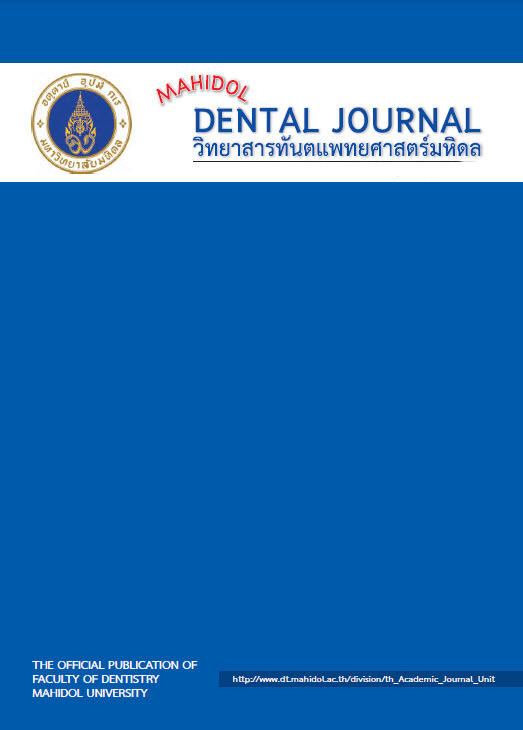Correlation between H angles and visual perception in skeletal type I females
Main Article Content
Abstract
Objective: To study the agreement among the hard tissue H angle, soft tissue H angle, and visual perception of facial profile in Thai patients with skeletal type I patterns.
Material and methods: Sixty-one lateral cephalograms of female patients of skeletal Type I patterns (ANB 1.97-5.69°) were hand traced and analysed. The outlines of the soft tissue profile of all cephalograms were separately traced and distributed to ten orthodontic residents to be rated for the convexity of the soft tissue profile using a visual analogue scale (VAS). Spearman’s rank-order correlation tests were used to analyse the relationship among the H angles and visual perception score.
Results: The mean values of the soft tissue and hard tissue H angles are 15.25±2.73° and 11.13±2.82° respectively, while the mean visual perception score points towards a very slightly convex profile. The soft tissue and hard tissue H angles were moderately correlated with each other (r=0.713; p<0.01). There were significant and equal correlations between the soft and hard tissue H angles with the visual perception score (r=0.441; p<0.01).
Conclusion: Both the soft and hard tissue H angles had the same degree of agreement with visual perception of the facial profile; hence, clinicians can choose either measurement to define the soft tissue profile in skeletal Type I adult patients.
Article Details
References
Siqueira DF, Sousa MV, Carvalho PE, do Valle-Corotti KM. The importance of the facial profile in orthodontic diagnosis and treatment planning: a patient report. World J Orthod. 2009; 10: 361-70.
Kim JC, Mascarenhas AK, Joo BH, Vig KW, Beck FM, Vig PS. Cephalometric variables as predictors of Class II treatment outcome. Am J Orthod Dentofacial Orthop. 2000; 118: 636-40.
Angle EH. Treatment of malocclusion of the teeth. Angle's system. 7th ed., greatly enl. and entirely rewritten, with six hundred and forty-one illustrations. Philadelphia: S.S. White dental manufacturing Co. ; 1907
Broadbent BH. A NEW X-RAY TECHNIQUE and ITS APPLICATION TO ORTHODONTIA. Angle Orthod. 1981; 51: 93-114.
Proffit WR. The soft tissue paradigm in orthodontic diagnosis and treatment planning: a new view for a new century. J Esthet Dent. 2000; 12: 46-9.
Merrifield LL. The profile line as an aid in critically evaluating facial esthetics. Am J Orthod. 1966; 52: 804-22.
Ricketts RM. Esthetics, environment, and the law of lip relation. Am J Orthod. 1968; 54: 272-89.
Burstone CJ, James RB, Legan H, Murphy GA, Norton LA. Cephalometrics for orthognathic surgery. J Oral Surg. 1978; 36: 269-77.
Steiner CC. The use of cephalometrics as an aid to planning and assessing orthodontic treatment: Report of a case. Am J Orthod. 1960; 46: 721-35.
Ricketts RM. Planning Treatment on the Basis of the Facial Pattern and an Estimate of Its Growth. The Angle Orthodontist. 1957; 27: 14-37.
Atchison KA, Luke LS, White SC. Contribution of pretreatment radiographs to orthodontists' decision making. Oral Surgery, Oral Medicine, Oral Pathology. 1991; 71: 238-45.
Reis SAB, Abrão J, Claro CAA, Fornazari RF, Capelozza Filho L. Concordância dos ortodontistas no diagnóstico do padrão facial. Dental Press Journal of Orthodontics. 2011; 16: 60-72.
Dechkunakorn S. Lateral cephalometric norms for Thai adults. J Dent Assoc Thai 1994; 44: 202-14.
Helms JE, Henze KT, Sass TL, Mifsud VA. Treating Cronbach’s alpha reliability coefficients as data in counseling research. The counseling psychologist. 2006; 34: 630-60.
Koo TK, Li MY. A guideline of selecting and reporting intraclass correlation coefficients for reliability research. J. Chiropr. Med. 2016 Jun 1; 15: 155-63.
Suchato W CJ. Cephalometric evaluation of the dentofacial complex of Thai adults. The Journal of the Dental Association of Thailand. 1984; 34: 233.
Ackerman JL, Proffit WR. Soft tissue limitations in orthodontics: treatment planning guidelines. Angle Orthod. 1997; 67: 327-36.
Hambleton RS. The soft-tissue covering of the skeletal face as related to orthodontic problems. Am J Orthod.50: 405-20.
Holdaway RA. A soft-tissue cephalometric analysis and its use in orthodontic treatment planning. Part I. Am J Orthod. 1983; 84: 1-28.
Kasai K. Soft tissue adaptability to hard tissues in facial profiles. Am J Orthod. 1998; 113: 674-684
Albarakati SF, Bindayel NA. Holdaway soft tissue cephalometric standards for Saudi adults. King Saud University Journal of Dental Sciences. 2012; 3: 27-32.
Hwang H-S, Kim W-S, Jr JAM. Ethnic Differences in the Soft Tissue Profile of Korean and European-American Adults with Normal Occlusions and Well-Balanced Faces. Angle Orthod. 2002; 72: 72-80.
Bishara SE, Jakobsen JR, Hession TJ, Treder JE. Soft tissue profile changes from 5 to 45 years of age. Am. J. Orthod. Dentofac. Orthop. 1998; 114: 698-706.
Kandel ER, Schwartz JH, Jessell TM, Biochemistry Do, Jessell MBT, Siegelbaum S, et al. Principles of neural science: McGraw-hill New York; 2000.
Shamlan MA, Aldrees AM. Hard and soft tissue correlations in facial profiles: a canonical correlation study. Clin Cosmet Investig Dent. 2015; 7: 9-15.
Huang Y-P, Li W-r. Correlation between objective and subjective evaluation of profile in bimaxillary protrusion patients after orthodontic treatment. Angle Orthod. 2015; 85: 690-8.


